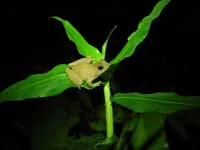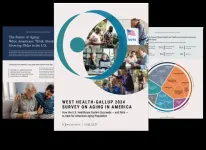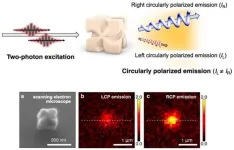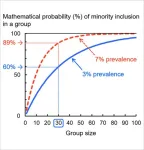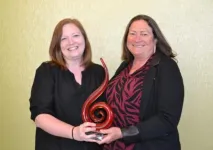(Press-News.org) Scientists have detected what they believe to be a neutron star spinning at an unprecedentedly slow rate —slower than any of the more than 3,000 radio emitting neutron stars measured to date.
Neutron stars - the ultra-dense remains of a dead star - typically rotate at mind-bendingly fast speeds, taking just seconds or even a fraction of a second to fully spin on their axis.
However, the neutron star, newly discovered by an international team of astronomers, defies this rule, emitting radio signals on a comparatively leisurely interval of 54 minutes.
The team was led by Dr Manisha Caleb at the University of Sydney and Dr Emil Lenc at CSIRO, Australia’s national science agency and includes scientists at The University of Manchester and the University of Oxford.
The results, published today in the journal Nature Astronomy, offer new insights into the complex life cycles of stellar objects.
Ben Stappers, Professor of Astrophysics at The University of Manchester, said: “In the study of radio emitting neutron stars we are used to extremes, but this discovery of a compact star spinning so slowly and still emitting radio waves was unexpected. It is demonstrating that pushing the boundaries of our search space with this new generation of radio telescopes will reveal surprises that challenge our understanding.”
At the end of their life, large stars use up all their fuel and explode in a spectacular blast called a supernova. What remains is a stellar remnant called a neutron star, made up of trillions of neutrons packed into a ball so dense that its mass is 1.4 times that of the Sun is packed into a radius of just 10km.
The unexpected radio signal from the stellar object detected by the scientists travelled approximately 16,000 light years to Earth. The nature of the radio emission and the rate at which the spin period is changing suggest it is a neutron star. However, the researchers have not ruled out the possibility of it being an isolated white dwarf with an extraordinarily strong magnetic field. Yet, the absence of other nearby highly magnetic white dwarfs makes the neutron star explanation more plausible.
Further research is required to confirm what the object is, but either scenario promises to provide valuable insights into the physics of these extreme objects.
The findings could make scientists reconsider their decades-old understanding of neutron stars or white dwarfs; how they emit radio waves and what their populations are like in our Milky Way galaxy.
Dr Kaustubh Rajwade, an Astronomer at the University of Oxford, said: “This discovery relied on the combination of the complementary capabilities of ASKAP and MeerKAT telescopes as well as the ability to search for these objects on timescales of minutes while studying how their emission changes from second to second! Such synergies are allowing us to shed new light on how these compact objects evolve.”
The discovery was made using CSIRO’s ASKAP radio telescope on Wajarri Yamaji Country in Western Australia, which can see a large part of the sky at once and means it can capture things researchers aren’t even looking for.
The research team were simultaneously monitoring a source of gamma rays and seeking a fast radio burst when they spotted the object slowly flashing in the data.
Lead author Dr Manisha Caleb from the University of Sydney Institute for Astronomy, said: “What is intriguing is how this object displays three distinct emission states, each with properties entirely dissimilar from the others. The MeerKAT radio telescope in South Africa played a crucial role in distinguishing between these states. If the signals didn’t arise from the same point in the sky, we would not have believed it to be the same object producing these different signals.”
The origin of such a long period signal remains a profound mystery, with white dwarfs and neutron stars the prime suspects. But as further investigations continue, this discovery is set to deepen our understanding of the universe’s most enigmatic objects.
END
Scientists detect slowest-spinning radio emitting neutron star ever recorded
2024-06-05
ELSE PRESS RELEASES FROM THIS DATE:
Tiny tropical puddle frogs show that protecting genetic variation is essential for animals to survive the climate crisis
2024-06-05
Even widespread species could be genomically vulnerable to the climate crisis, scientists warn. By studying the DNA of puddle frogs living in central African rainforests, the scientists found that areas of high environmental variation foster high genetic variation. If these varied habitats and the frogs that live there are lost, genetic variants that could have allowed the species to evolve to survive the climate crisis could be lost too. Meanwhile, populations with low genetic variation could become extinct quickly, unable to adapt.
“Generally, the more genomic variation within ...
3 in 4 Americans under 65 are worried about future of Medicare
2024-06-05
WASHINGTON, D.C. — June 5, 2024 — Concerns over the potential insolvency of Medicare among those under 65 have risen, with 73% now expressing worry that it won’t be available when they need it, up from 67% in 2022, according to the new West Health-Gallup 2024 Survey on Aging in America. Worry rose most amongst those aged 50 to 64, up 13 percentage points to 74%. Higher percentages of adult’s express concern about the future of Social Security, with 80% of people under 62 and 86% of people aged 40 to 49 fearing it will not be around once they are eligible.
According ...
Gold nanoparticles that selectively emit left-/right-handed light
2024-06-05
doi.org/10.1002/adom.202400699When chiral(1) gold nanoparticles(2) are irradiated with near-infrared(3) femtosecond pulses(4), visible emission of luminescence is observed. In this study, this luminescence was found to yield high selectivity for left- or right-handed circularly polarized(5) light, depending on the chirality of the nanoparticles, with a dissymmetry factor(6) of approximately 0.7. This finding suggests the potential to elevate various applications using circularly polarized light to practical levels.
Abstruct
The research group led by Project Assistant Professor Dr. Hyo-Yong AHN, ...
New AI algorithm detects rare epileptic seizures
2024-06-05
More than 3.4 million people in the US and 65 million people worldwide have epilepsy, a neurological disorder that affects the nervous system and causes seizures. One in 26 people will develop epilepsy at some point in their lives, and 1 out of 1000 people with epilepsy die from unexpected deaths each year.
Like many conditions, epilepsy treatment starts with early detection. The World Health Organization estimates that 70% of people with epilepsy could live seizure-free if adequately diagnosed and treated.
Over the years, ...
People underestimate the probability of including at least one minority member in a group
2024-06-05
Niigata, Japan - Human society includes various minority groups. However, it is often difficult to know whether someone is a minority member simply by looking at the person, as minority traits may not be visually apparent (e.g., sexual orientation, color vision deficiency). In addition, minorities may hide their minority traits or identities. Consequently, we may have been unaware of the presence of minorities in daily life. Probabilistic thinking is critical in such uncertain situations. The people with whom we interact in our daily lives are typically a group of several dozen individuals (e.g., a school class). How do we judge the probability of including at least one minority ...
Celebrate Pride Month by learning CPR. The life you save may be someone you love
2024-06-05
DALLAS, June 4, 2024 — According to the American Heart Association, when someone suffers a cardiac arrest, immediate cardiopulmonary resuscitation (CPR) is critical and can double or triple a person’s chance of survival. More than 350,000 out-of-hospital cardiac arrests occur in the United States each year. Of those, 90% will not survive, according to the Association, which is working to turn more bystanders into lifesavers who can use CPR in an emergency. The American Heart Association, celebrating one hundred years of lifesaving service as a global ...
Dr. Erin Belval honored for exemplary fire science research
2024-06-05
FORT COLLINS, Colo., June 4, 2024 — Dr. Erin Belval, a research forester at the USDA Forest Service Rocky Mountain Research Station, was awarded the Early Career Scientist Award in Fire Science from the International Association of Wildland Fire (IAWF). She received the honor last month at the 2024 International Wildland Fire Conference in Boise, Idaho.
The award recognizes promising early-career professionals who demonstrate outstanding ability in any field of wildland fire science. Belval was nominated by colleagues and peers for her outstanding contributions.
“The award is particularly meaningful because ...
A novel approach to tracking conservation reveals more areas may be conserved than currently accounted for
2024-06-05
(Santa Barbara, Calif.) — Thirty by thirty. It’s an ambitious answer to growing calls for protecting more of our planet’s surface. The goal is to conserve 30% of the Earth’s oceans, lands and freshwaters by 2030. While this may seem a lofty aim, the diversity and coverage of conservation areas today might be greater than what’s currently recognized by global tracking systems.
An international team of conservation researchers and practitioners, led by scientists at UC Santa Barbara and The Nature Conservancy, has developed an inclusive inventory approach for tracking ...
Commonly used alcohol-based mouthwash brand disrupts the balance of your oral microbiome, scientists say
2024-06-05
SUMMARY
Researchers have identified a significant change in composition and abundance of bacteria in study participants’ oral microbiomes after using a popular brand of alcohol-based mouthwash.
The oral microbiome is the community of bacteria that live in the mouth, they help us digest our food and keep our mouth healthy.
Researchers found that two species of opportunistic bacteria were significantly more abundant in the mouth after daily use of the alcohol-based mouthwash, Fusobacterium nucleatum and Streptococcus anginosus. ...
Injury prediction rule could decrease radiographic imaging exposure in children, study shows
2024-06-05
(COLUMBUS, Ohio) – While cervical spine injuries (CSI) are uncommon in children, they can be potentially devastating, resulting in quadriplegia – paralysis below the neck affecting both arms and both legs. Detecting CSIs in a clinical setting often requires imaging such as X-rays and computed tomography (CT) scans, both of which expose children to radiation, which can cause other health issues over time.
In a study published today in The Lancet Child & Adolescent Health, researchers in the Pediatric Emergency Care Applied Research Network (PECARN) – led by Julie Leonard, MD, MPH at Nationwide Children’s Hospital –created a highly accurate ...
